VANCOUVER, British Columbia, Feb. 03, 2025 (GLOBE NEWSWIRE) — Entrée Resources Ltd. (TSX:ETG; OTCQB:ERLFF – the “Company” or...
Vous n'êtes pas connecté
- English
- Français
- عربي
- Español
- Deutsch
- Português
- русский язык
- Català
- Italiano
- Nederlands, Vlaams
- Norsk
- فارسی
- বাংলা
- اردو
- Azərbaycan dili
- Bahasa Indonesia
- Հայերեն
- Ελληνικά
- Bosanski jezik
- українська мова
- Íslenska
- Türkmen, Түркмен
- Türkçe
- Shqip
- Eesti keel
- magyar
- Қазақ тілі
- Kalaallisut ; kalaallit oqaasii
- Lietuvių kalba
- Latviešu valoda
- македонски јазик
- Монгол
- Bahasa Melayu ; بهاس ملايو
- ဗမာစာ
- Slovenščina
- тоҷикӣ ; toğikī ; تاجیکی
- ไทย
- O'zbek ; Ўзбек ; أۇزبېك
- Tiếng Việt
- ភាសាខ្មែរ
- རྫོང་ཁ
- Soomaaliga ; af Soomaali
Rubriques :
 Maroc - EURASIAREVIEW.COM - A la une - 09/Feb 01:26
Maroc - EURASIAREVIEW.COM - A la une - 09/Feb 01:26
The Hidden Cost Of Mongolia’s Mining Boom – Analysis
By Narantuya Chuluunbat Mongolia’s burgeoning mining sector is a cornerstone of its economy. But it comes with inherent challenges, including environmental degradation, income inequality and community displacement. Mongolia’s policymakers must navigate the trade-offs between boosting economic growth by exploiting natural resources and preserving environmental integrity. The mining sector accounted for 28.7 per cent of Mongolia’s GDP, 92.1 per cent of exports and 31.6 per cent of fiscal revenue in 2023 — one of the highest among resource-rich countries. The sector directly employed 73,180 people in 2023 — 5.7 per cent of total employment — and an estimated 60,000 in small-scale artisanal mining, a substantial source of employment in rural areas. Mining also supports numerous indirect jobs through related industries and services. One of the primary environmental concerns is the depletion of water reserves. This is especially salient in the South Gobi region of Mongolia, where large mines account for 78.3 per cent of regional water use in an already water-scarce area. Mining uses 15 per cent of the country’s total water, and demand is expected to rise 2.4-fold by 2040, outstripping underground water reserves. The extraction process also significantly contributes to soil erosion and land degradation. In Mongolia, roughly 72 per cent of the land is degraded, with an estimated 100,000 hectares affected by coal and gold mining. Mining has disrupted the livelihoods of nomadic herders, leading to displacement and loss of grazing land. Agriculture employs 27.9 per cent of the country’s labour force, and animal husbandry is the sole source of livelihood for 62.2 per cent of rural households. The sector currently contributes 9.8 per cent of GDP, down from 27.4 per cent in 2000. As such, this structural shift has favoured mining at the considerable expense of agriculture. Since the early 2000s, clashes between mining companies and herders over land and water use have intensified, prompting the introduction of Local-Level Agreements (LLAs) into law. Several hundred LLAs have been established over the past decade. The Oyu Tolgoi South Gobi Agreement is a notable example. Herders’ concerns with the Oyu Tolgoi mining project included the loss of pastureland, dust from road traffic harming livestock health, risks associated with unfenced quarries and anxiety over underground water use depleting local water. The Oyu Tolgoi South Gobi Agreement involved local populations in negotiations and resulted in a mutually agreeable resolution through a layered, ongoing dialogue. But the Oyu Tolgoi South Gobi Agreement is an exception rather than the rule. Mongolia’s legal framework for LLAs is overly prescriptive and does not recognise the affected communities as true negotiating parties. This limits meaningful participation by the affected local community in the agreement-making process, leading to short-term agreements that are often too broad, do not address specific concerns and are not monitored to ensure implementation. LLAs are an integral part of the ‘social licence to operate’ concept, an essential tool for community engagement with mining projects. The social licence to operate concept emphasises securing genuine community approval for mining projects. In Mongolia, community opposition has led to delays, disruptions and even the shutdown of mining operations, highlighting the importance of securing and maintaining this social licence to avoid costly consequences. The importance of preserving nomadic pastoralism goes beyond negotiating the coexistence of mining and herders. Nomadic pastoralism is an essential source of economic diversification, an ongoing goal and challenge for successive Mongolian governments. Improving economic diversification becomes ever more pressing as the mining sector grows exponentially, but it remains little more than wishful thinking. Still, the current shift in global consumer preferences and emerging Asian markets provide Mongolia with an opportunity to cater to niche markets with high-quality products. In addition to a resilient cashmere sector, there has been a recent surge in large companies’ investment in meat production and a considerable expansion of meat exports. Quality is a selling point, so preserving pastures will be essential to distinguish Mongolian animal products from those of competitors. The government has made significant strides in developing environmental regulations to ensure sustainable mining practices and align Mongolia’s mining laws to global standards. Mongolian law requires mining projects undergo rigorous environmental assessments. Unfortunately, the new environmental regulations remain effective only on paper. Enforcement remains weak, and stronger compliance and more frequent regulation updates are needed to improve the effectiveness of Mongolia’s environmental regulations. The mining sector can still be efficient under strict environmental regulations if advanced technology is used and adequate infrastructure is in place. But this is not the case in Mongolia because the government has focused on raising fiscal revenue and made limited efforts to improve infrastructure. A strategic, forward-looking approach to ensuring the sector’s sustainabilitydemands that Mongolia’s policymakers invest in infrastructure while boosting the enforcement of the existing environmental regulations. This dual task is long overdue and will level up the entire mining–environment game. Government regulations alone will not preserve Mongolia’s environment. At the local level, resource companies must be expected to negotiate effectively and reach an agreement with multiple stakeholders. Genuine and meaningful local engagement is essential to addressing the growing problem of pasture degradation. Herders can find powerful allies in animal product processing companies, as they have shared interests in safeguarding the health of Mongolia’s animals and the environment. About the author: Narantuya Chuluunbat is Professor at the Economics Department of the National University of Mongolia. Source: This article was published at East Asia Forum
Articles similaires
The hidden cost of Mongolia’s mining boom
As Mongolia's mining sector drives unprecedented economic growth, the nation grapples with preserving its ancient pastoral heritage and fragile...
Cease all mining activities in, around water bodies now -EPA cautions miners
The Environmental Protection Authority (EPA) Tuesday issued a directive to all individuals and entities involved in illegal mining (galamsey) in and...
Climate warnings spur innovation for Trinidad and Tobago’s green economy
INDEPENDENT senator Anthony Vieira’s stark warning to legislators and the general public of an environmental “triple-whammy” hung in the air on...
Mongolia: Petro Matad awarded certification of Block XX Exploitation Area as State Special Purpose Land
Petro Matad, the AIM quoted Mongolian oil company, confirms that after completion of the certification process, the Block XX Exploitation Area which...
‘Everyone is subject to the same conditions’
–President Ali emphasises ‘openness, transparency’ in housing sector –less than 10 per cent of land allocations went to private...
Future-focused students less than keen on mining careers fuel fears of industry shortfall
The mining and geoscience industry is facing an uphill battle in trying to convince the Australian youth to take up study in the sector.
Trinidad and Tobago moves closer to commercialised methanol fuel
TT is now one step closer to having blended methanol fuel commercially available after a recently concluded demonstration programme showed locally...
Trump Issues Executive Order On Crypto And Central Bank Digital Currencies – OpEd
By Peter Jacobsen Trump’s first weeks in office have involved a flurry of executive orders. Some have been dramatic, such as the federal...
GraceKennedy acquires 100% of Catherine's Peak
GraceKennedy (GK) Limited has disclosed that it has come to an agreement with Spike Industries Limited to acquire its remaining 30 per cent stake in...
Les derniers communiqués
-
Adobe Brings Conversational AI to Trillions of PDFs with the New AI Assistant in Reader and Acrobat
Adobe - 21/02/2024
-
Laura Frigenti takes the Helm as Chief Executive Officer of the Global Partnership for Education
Global Partnership for Education - 05/12/2022


